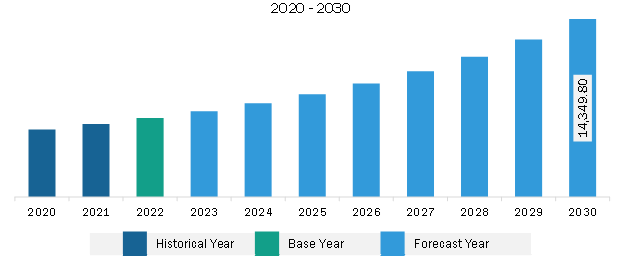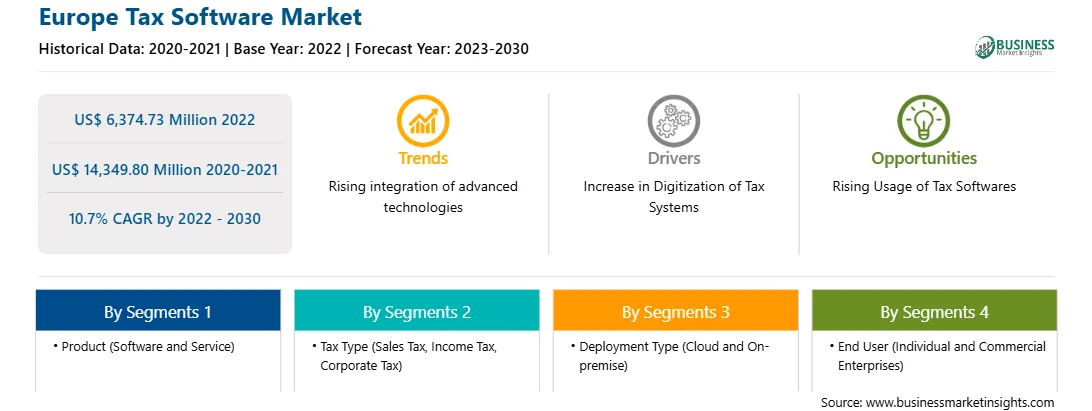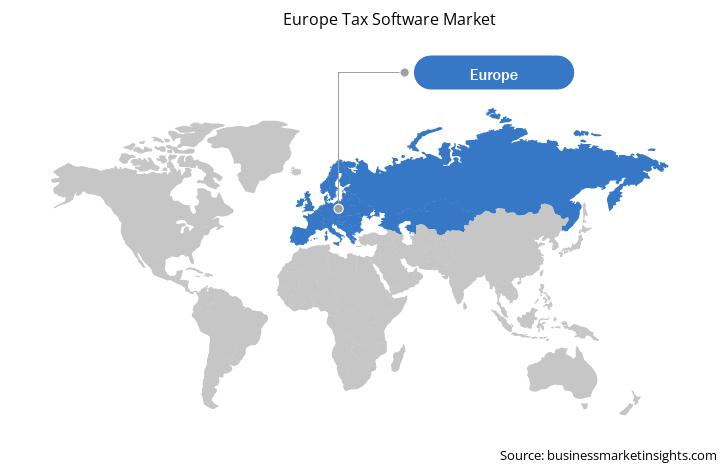The Europe tax software market is expected to grow from US$ 6,374.73 million in 2022 to US$ 14,349.80 million by 2030. It is estimated to grow at a CAGR of 10.7% from 2022 to 2030.
The digital payments ecosystem has gained traction in recent years. The internet penetration and the rise in usage of smartphones are some of the prominent factors fueling digital payments. The rise in online shopping and e-commerce sector also has also increased in the pandemic, which has led to the growth of the online financial transactions. These transactions were made for the first time after the start of the pandemic. The number of digital transactions is growing year by year. Thus, the growing online transaction generates the demand for digital solutions. A tax software offers numerous advantages that helps the individual and businesses to streamline transaction tracking and simplify business finances. Effective transaction tracking is vital for the smooth operation of any business. The tax software ensures that every transaction is recorded, making financial data analysis and decision-making easier. It also ensures legal and regulatory compliance. Its calculation functions guarantee accurate tax calculations and minimize the risk of incorrect tax filing. It makes the complex task of tax filing easier by automating the generation of GST and VAT reports. Thus, the rise in online transactions creates complexity in financial management, which further generates the need for the tax software market in the coming years.
The Europe tax software market is segmented into Germany, France, Italy, the UK, Russia, and the Rest of Europe. Different countries have different tax rates decided by their respective national government; the European Union (EU) does not have a direct role in setting tax rates and collecting taxes. EU overlooks national tax rules concerning businesses and consumer policies to ensure taxes do not differentiate against consumers, employees, or businesses from other EU countries and to check if any businesses in one country do not have a biased advantage over competitors in another. EU works with its countries with an aim to make efficient and growth-friendly economic policies and corporate and income taxes. These tax rate continuously changes according to the economic environment, economic performance of countries, and other factors, which creates confusion and complexity among the individual and businesses to cope with the updated tax compliances. For example, according to the European Commission, the tax structure in 2021 was nearly like the pre-COVID-19 period, but the share of labor tax dropped to 51.4% in 2021, a drop of 1.9 percentage points (pp) compared to the 2020 tax structure. Similarly, consumption taxes rose to 11.2%, and revenue from taxes on capital also rose to 8.5%. In such cases, the adoption of tax software by individuals and businesses helps to get updated tax rates. The updated changes in tax rates and rules helps them to file the tax effectively and efficiently. The software tracks all transactions and tracks eligible tax credits with respect to tax compliances. Thus, the rising awareness regarding the benefits of tax software has surged its adoption, thereby favoring the tax software market in Europe.
Europe has wide automotive, fashion, and other industry vertical players that have grown their presence worldwide and plan to expand. In addition, they are also expanding their business online. As countries in different regions have diverse corporate tax rates and digital services tax, a tax software solution helps various industries manage tax obligations on those transactions. The solution helps them get a revised or new tax regime and manage their taxes according to it, leading to the demand for tax software from various industry's customers. The tax software market players are also launching various solutions that propel the tax software market growth in Europe. For example, in August 2023, Stripe launched Stripe Tax for platforms, enabling platforms using Stripe Connect to offer Stripe Tax as a service to their customers. The solution helps businesses to sell their products cross-boarders and adhere to complex tax requirements.

Strategic insights for the Europe Tax Software provides data-driven analysis of the industry landscape, including current trends, key players, and regional nuances. These insights offer actionable recommendations, enabling readers to differentiate themselves from competitors by identifying untapped segments or developing unique value propositions. Leveraging data analytics, these insights help industry players anticipate the market shifts, whether investors, manufacturers, or other stakeholders. A future-oriented perspective is essential, helping stakeholders anticipate market shifts and position themselves for long-term success in this dynamic region. Ultimately, effective strategic insights empower readers to make informed decisions that drive profitability and achieve their business objectives within the market.

| Report Attribute | Details |
|---|---|
| Market size in 2022 | US$ 6,374.73 Million |
| Market Size by 2030 | US$ 14,349.80 Million |
| Global CAGR (2022 - 2030) | 10.7% |
| Historical Data | 2020-2021 |
| Forecast period | 2023-2030 |
| Segments Covered |
By Product
|
| Regions and Countries Covered | Europe
|
| Market leaders and key company profiles |
The geographic scope of the Europe Tax Software refers to the specific areas in which a business operates and competes. Understanding local distinctions, such as diverse consumer preferences (e.g., demand for specific plug types or battery backup durations), varying economic conditions, and regulatory environments, is crucial for tailoring strategies to specific markets. Businesses can expand their reach by identifying underserved areas or adapting their offerings to meet local demands. A clear market focus allows for more effective resource allocation, targeted marketing campaigns, and better positioning against local competitors, ultimately driving growth in those targeted areas.

The Europe tax software market is segmented into product, deployment, tax type, end user, and country.
Based on product, the Europe tax software market is bifurcated into software and services. The software segment held a larger share of the Europe tax software market in 2022.
In terms of deployment type, the Europe tax software market is bifurcated into cloud and on-premise. The cloud segment held a larger share of the Europe tax software market in 2022.
Based on tax type, the Europe tax software market is segmented into sales tax, income tax, corporate tax, and others. The sales tax segment held the largest share of the Europe tax software market in 2022.
Based on end user, the Europe tax software market is bifurcated into commercial enterprises and individual. The commercial enterprises segment held a larger share of the Europe tax software market in 2022. Further, commercial enterprises segment is categorized into enterprise size (large enterprises, medium enterprises, and small enterprises) and vertical (IT & Telecom, retail, BFSI, government, healthcare, and others).
Based on country, the Europe tax software market is segmented into Germany, the UK, France, Italy, Russia, and the Rest of Europe. The Rest of Europe dominated the Europe tax software market in 2022.
Sage Group Plc, Thomson Reuters Corp, Xero Ltd, IRIS Software Group Ltd, Wolters Kluwer NV, Intuit Inc, HRB Digital LLC, and SAP SE are some of the leading companies operating in the Europe tax software market.
1. Sage Group Plc
2. Thomson Reuters Corp
3. Xero Ltd
4. IRIS Software Group Ltd
5. Wolters Kluwer NV
6. Intuit Inc
7. HRB Digital LLC
8. SAP SE
The Europe Tax Software Market is valued at US$ 6,374.73 Million in 2022, it is projected to reach US$ 14,349.80 Million by 2030.
As per our report Europe Tax Software Market, the market size is valued at US$ 6,374.73 Million in 2022, projecting it to reach US$ 14,349.80 Million by 2030. This translates to a CAGR of approximately 10.7% during the forecast period.
The Europe Tax Software Market report typically cover these key segments-
The historic period, base year, and forecast period can vary slightly depending on the specific market research report. However, for the Europe Tax Software Market report:
The Europe Tax Software Market is populated by several key players, each contributing to its growth and innovation. Some of the major players include:
The Europe Tax Software Market report is valuable for diverse stakeholders, including:
Essentially, anyone involved in or considering involvement in the Europe Tax Software Market value chain can benefit from the information contained in a comprehensive market report.